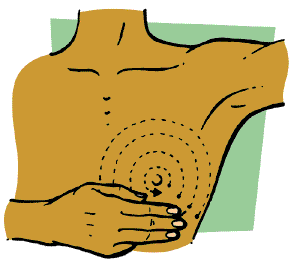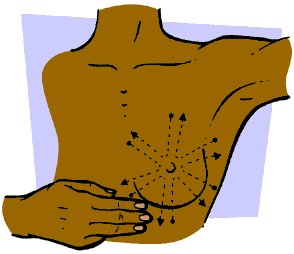Breast Self Exam (BSE)....
BREAST CANCER EDUCATION PROJECT
 Christine Tripp's House of
Concern (HOC) sponsored an early detection breast cancer
education project for low income women and men. The project had
several components. First, the placement of shower plaques in as
many homes as funds would allow. Second, providing transportation to and from sites offering free mammograms.
Third, by providing a support system when treatment was necessary. Christine Tripp's House of
Concern (HOC) sponsored an early detection breast cancer
education project for low income women and men. The project had
several components. First, the placement of shower plaques in as
many homes as funds would allow. Second, providing transportation to and from sites offering free mammograms.
Third, by providing a support system when treatment was necessary.
HOC conducted workshops and
seminars on the importance of self-breast examination and
demonstrated how to exam the breast. Participants were trained
to provide workshops and seminars in their places of worship,
job sites, and homes.
Most importantly, HOC recruited and trained buddies to be support systems for persons
going through treatment. Buddies were available until the
person made a complete recovery.
Learn To Perform a Breast Self-Exam
Become bosom buddies with
your breasts
Knowing your breasts can save your life. If you are a woman aged
20 or older, a monthly breast self-exam is imperative to your
health. It will help you know exactly how your breasts normally
look and feel. It will also make it easier for you to discover
any abnormalities and report them to your doctor.
If you think you don't have time or aren't at risk, think
again:
- Breast cancer is the second
highest cause of cancer-related deaths in women.
- One out of every eight women
living in the United States will be diagnosed with breast
cancer in her lifetime.
- 90 to 95 percent of breast
cancer that is detected early can be cured.
- Most breast lumps are found
by women doing breast self-exams.
- You owe it to yourself to
take the time to do it right.
 If you perform
your breast self-exam on the same day each month, it will become
an easy routine to remember. If you menstruate, the best time to
do an exam is two to three days after your period ends. This is
when your breasts are at their least tender. If you no longer
menstruate, you should pick the same day each month (the date
that matches your birthday is an easy-to-remember choice). If
you take hormones, check with your doctor about the best time to
do it. No matter what date you pick, you should also have your
doctor check your breasts each year. If you perform
your breast self-exam on the same day each month, it will become
an easy routine to remember. If you menstruate, the best time to
do an exam is two to three days after your period ends. This is
when your breasts are at their least tender. If you no longer
menstruate, you should pick the same day each month (the date
that matches your birthday is an easy-to-remember choice). If
you take hormones, check with your doctor about the best time to
do it. No matter what date you pick, you should also have your
doctor check your breasts each year.
Another important factor is to find the right place. Many women
prefer a warm, private room where they feel comfortable, such as
the bathroom or bedroom. The room should have a well-lit mirror
and plenty of space to lie down.
The most common signs of breast cancer include:
- A painless lump in the
breast or under the arm
- Abnormal thickening of the
breast tissue
- A change in breast density
Less common signs include:
- Redness, puckering, scaling
or dimpling of the skin over the breast
- Nipple discharge or
inversion
Stand in front of a mirror in a
well-lit area so you can see your breasts clearly. Look at each
breast for anything unusual such as:
- Nipple discharge or
inversion
- Skin that is red, puckered,
dimpled, or scaly
Next, check for changes in your
breasts' shape. To do this, clasp your hands behind your head
and press them forward. Pay attention to how this effects each
breast. Then put your hands firmly on your hips, and bend
slightly forward. As you bend, hunch your shoulders and pull
your elbows forward. This will give you a good idea of your
breasts' natural contours, and will make it easy for you to
detect any changes.
Choose your pattern
You can choose from three different patterns to examine your
breasts--each works equally well. Just pick the one that makes
you feel the most comfortable and is easiest for you to examine
all the necessary areas, which include both breasts, your
underarms, and your upper chest (up to your collarbone). You can
combine patterns if doing so makes it easier to check
everything. The explanations below describe how to cover the
breasts with each pattern.
Circles: Begin at the very outer edge of the breast,
moving your fingers slowly around the entire breast until you
complete a circle. Then move inward a little and make a smaller
circle. Continue making smaller and smaller circles, working
toward the nipple until you've covered the entire breast.
Starting at the bottom edge of one side of your breast, move
your fingers slowly upward until you hit the uppermost edge of
the same side. Then move your fingers slightly over toward the
center of the breast. Slowly move them downward until you are at
the base of your breast once again. Cover the whole breast using
this up and down pattern.
Wedges: Start at the outer edge of the breast and move
your fingers slowly toward the nipple and then back to the edge
again. Check the whole breast, covering one wedge-shaped section
at a time.
Check for lumps and thickness
Using your chosen pattern, you can examine your breasts for
lumps and thickness. If you prefer, you can do this part in the
shower, since water makes it easier for your hands to glide over
your skin. You can also use powder, lotion, body oil, or nothing
at all.
- Raise one arm and put your
hand behind your head.
- With the opposite hand, use
the pads of three fingers (where your fingerprints are, not
the tips) to check the breast. You will feel a ridge of tissue
in the lower curve of your breast. Also check the area between
the breast and underarm, the underarm itself, and the area
above the breast (all the way up to your collarbone and
shoulder) to cover the breast tissue that extends toward the
shoulder.
- Carefully check each area
completely. Use enough pressure to feel different breast
tissues, including the skin, the tissue just beneath it, and
the deeper tissue (as close to your ribs as you can get
without discomfort).
- Raise the other arm, put it
behind your head, and then check the opposite side.
- Once you've checked both
breasts (and are out of the shower and dry), gently squeeze
each of your nipples between your thumb and index finger. If
you notice any clear or bloody discharge, you should report it
to your doctor immediately after your self-exam.
Lie down and repeat Step 3
Find a comfortable spot where
you can lie flat on your back, such as a soft carpet or mat, or
even your bed if it's firm. Lying on your back will cause your
breasts to flatten out against your chest. Sometimes it's easier
to feel lumps in this position.
Place one hand behind your head and a pillow or folded towel
under your shoulder on the same side. Use the opposite hand to
begin the exam. When you're done with the first side, switch to
the other hand (and move the pillow or towel, too) to do the
other side.
When you've completed the exam, be happy knowing that you're
well on your way toward staying healthy.
-end-
A woman's risk for breast
cancer increases with age. Mammograms can reveal breast cancer
up to two years before it can be felt. If you are age 40 to 49,
you should get a mammogram every one to two years. If you are
age 50 or above, you should get a mammogram once per year.
A small percentage of men are diagnosed with breast cancer each
year. All men should be aware of the risk factors (family
history, growing older, Klinefelter's syndrome, Gynecomastia,
testicular dysfunction) and report any changes in their breasts
to their physician.
Most breast lumps are completely normal and harmless. However,
it's important to report any lumps you find to your doctor.
This information is brought to you by the House Of Concern
Breast Cancer Education Project
 
|